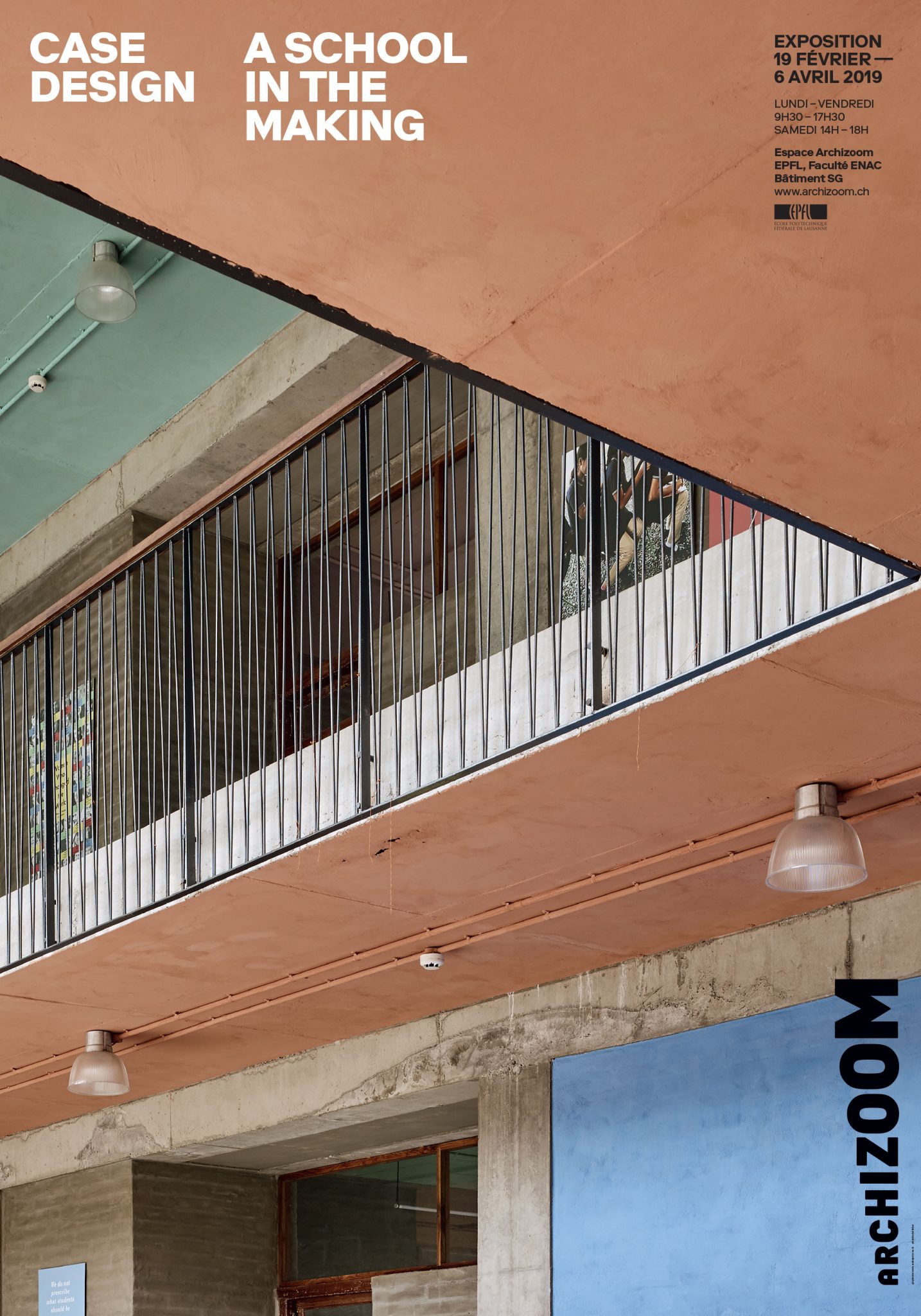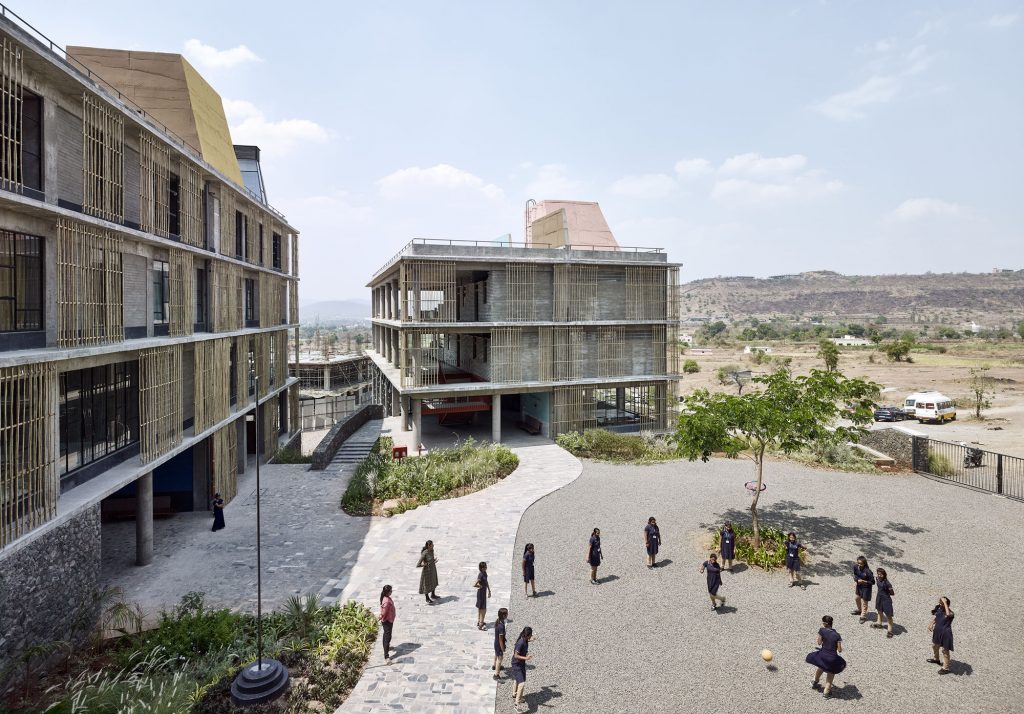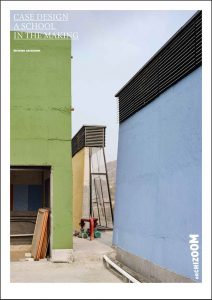
Exhibition from 19 February until 6 April 2019
Opening Monday 18 February at 18:00, Lecture by Sam Barclay, Mumbai
By bringing together a diverse group of builders, designers, farmers, artists, craftsmen, and engineers who share a belief that collaboration and empathy lie at the core of all good work, the Mumbai based architecture practice Case Design creates moments of hospitality, social interaction, reflection, play, ritual, seclusion, performance, and comfort.

Architecture seems to step back in order to orchestrate a careful balance of multiple operations that meet on a common project. When the Centenary year of the Bauhaus begins, we can to see here a new form of architectural Gesamtkunstwerk. Multidisciplinary influences–including education, art and craft–integrated in an economically viable construction advocates the true Bauhaus’ rationale.
The simple concrete structures that establish the built environment of the campus are designed for their economic efficiency as well as their flexibility and readiness to adapt. This rudimentary framework enables a process of dialogue allowing everyone to participate in the process of making this school. A collection of indoor and outdoor spaces intended for a variety of uses, the campus is designed to give a sense of familiarity and intimacy to the young women living and studying here. They are made in response to what is already there; climate, landscape, materials, routines, traditions and memory. Nurtured and adapted throughout the design and on the building site, these spaces have evolved with the influence, expertise, and enthusiasm of collaborators.
The passive cooling system developed with climate engineer Pratik Raval prescribed exposed concrete ceilings and stone flooring to provide thermal mass. In response we worked with contractor Rameshwar Bhadhwa to create coloured stone mosaic flooring from waste material and visual artist Malene Bach developed a series of natural pigmented colours for all of the ceilings. Her colours transform each space but are also a response to the surrounding landscape, for which artists Teja Gavankar and Vishal Kadam developed a series of astronomical instruments which are simultaneously artistic elements and scientific apparatus for the campus. Mira Nakashima’s donation of a Table of Peace initiated the idea for a Peace Pavilion, set in the landscape as an intimate space for tranquility and introspection. The benches, showcases and other wooden elements were developed with a team of carpenters from Rajasthan.
Together with the large photographs of the school captured at different moments by Ariel Huber, the exhibition shows how construction, landscape and craftsmanship are generated through rigorous practice, strong conviction and a process of inclusion.
This exhibition has been produced by Case Design and Archizoom EPFL for the Biennale di Venezia 2018
Settled into the valley slope above the small village of Lavale and still a work-in-process, Avasara Academy is a residential school for young women in India.
Book published by Archizoom
Text: Ellen E. Donnelly
Photographic essay: Ariel Huber
Interviews with collaborators of Avasara Academy
Settled into the valley slope above the small village of Lavale, Avasara Academy is a residential school for young women in western India and is still a work in process. With thoughtful attention to both physical and social environments, the school is evolving through a design-build process focused on inclusion and engagement.
A diverse group of builders, designers, farmers, artists, craftsmen and engineers has been involved in making the school, showing the potential and possibilities of an architectural practice based on collaboration and empathy. About Case Design
“While many architects hold tightly to the primacy of drawing, Case Design’s process flattens the hierarchy of drawing-over-constructing and instead foregrounds the importance of an open-ended design process highly dependent on continual dialogue between the architects, craftsmen, clients and other design collaborators.” Ellen E. Donnelly
Case Design develops a kind of architectural syncretism that pragmatically borrows from vernacular as well as modern architecture, and from local know-how as well as international expertise. The method encompasses what the essence of all architecture should be. It relates to the Vitruvian principle of architecture as craftsmanship and science, which depends on many disciplines and apprenticeships carried out in other arts and techniques. It also follows modern functionalist conventions: concrete columns and slabs that bear the structural load allow for a “plan libre” with unrestrained internal use and a thin skin façade independent of the structure. The Corbusian Dom-Ino model was the most affordable solution to let the architecture express itself.
To borrow from Charles Darwin’s description of how life evolved on earth, Case Design has let “mutual affinities” and “hybridism” unfold during the construction, generating vital diversity and activities. The photographic essay and interviews published here present buildings in construction and spaces that are already actively used by their inhabitants. Each page of this book wishes to witness the flourishing effervescence of life happening on Avasara campus. This is the telling of an essential story of architecture.
Cyril Veillon, director of Archizoom
Order the exhibition catalogue
